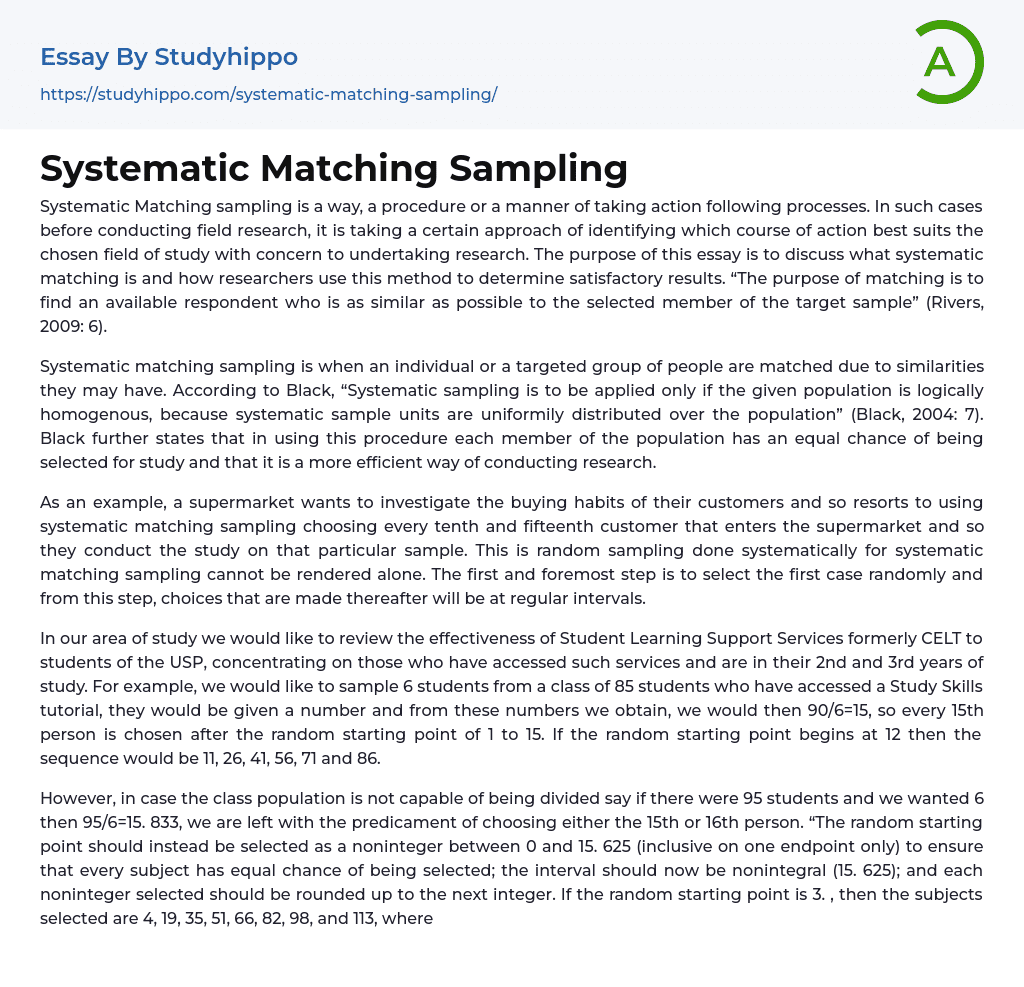Systematic Matching sampling is a way, a procedure or a manner of taking action following processes. In such cases before conducting field research, it is taking a certain approach of identifying which course of action best suits the chosen field of study with concern to undertaking research. The purpose of this essay is to discuss what systematic matching is and how researchers use this method to determine satisfactory results. “The purpose of matching is to find an available respondent who is as similar as possible to the selected member of the target sample” (Rivers, 2009: 6).
Systematic matching sampling is when an individual or a targeted group of people are matched due to similarities they may have. According to Black, “Systematic sampling is to be applied only if the given population is logically homogenous, because systematic s
...ample units are uniformily distributed over the population” (Black, 2004: 7). Black further states that in using this procedure each member of the population has an equal chance of being selected for study and that it is a more efficient way of conducting research.
As an example, a supermarket wants to investigate the buying habits of their customers and so resorts to using systematic matching sampling choosing every tenth and fifteenth customer that enters the supermarket and so they conduct the study on that particular sample. This is random sampling done systematically for systematic matching sampling cannot be rendered alone. The first and foremost step is to select the first case randomly and from this step, choices that are made thereafter will be at regular intervals.
In our area of study we would like to review the effectiveness
of Student Learning Support Services formerly CELT to students of the USP, concentrating on those who have accessed such services and are in their 2nd and 3rd years of study. For example, we would like to sample 6 students from a class of 85 students who have accessed a Study Skills tutorial, they would be given a number and from these numbers we obtain, we would then 90/6=15, so every 15th person is chosen after the random starting point of 1 to 15. If the random starting point begins at 12 then the sequence would be 11, 26, 41, 56, 71 and 86.
However, in case the class population is not capable of being divided say if there were 95 students and we wanted 6 then 95/6=15. 833, we are left with the predicament of choosing either the 15th or 16th person. “The random starting point should instead be selected as a noninteger between 0 and 15. 625 (inclusive on one endpoint only) to ensure that every subject has equal chance of being selected; the interval should now be nonintegral (15. 625); and each noninteger selected should be rounded up to the next integer. If the random starting point is 3. , then the subjects selected are 4, 19, 35, 51, 66, 82, 98, and 113, where there are 3 cyclic intervals of 15 and 5 intervals of 16” (Black, 2004: 7). We would choose from the general USP student population those who are in their 2nd and 3rd years as our target sample. Ideally we would interview the respondents in the target sample. However, the limitations are that most would not be available for
interviews as they are students and that we would not have the time or the money to go chasing after the targeted sample students.
They might not provide us with contact information such as an email addresses. There would be hiccups in our area of study like the possibility of there not being enough 2nd or 3rd years who have accessed or are accessing Student Support Services, then we would match them with other students who are in their first year or post graduate level and who have accessed one of these services like Study Skills. We will try to gauge from the material collected whether they have benefited from the Study Skills sessions by improving their grades.
This method of research though makes data processing manageable but since it is a form of non-random sampling, cautionary measures should be used. According to Bouma et al, the researcher must be aware of the limitations of conclusions about the population based non-random sampling procedures. In using Systematic Matching Sampling, we have to be conscious of the variables that we intend to use and on formulating the relevant questions with regards to the research topic.
- Research Methods essays
- Experiment essays
- Hypothesis essays
- Observation essays
- Qualitative Research essays
- Theory essays
- Explorer essays
- Normal Distribution essays
- Probability Theory essays
- Variance essays
- John Locke essays
- 9/11 essays
- A Good Teacher essays
- A Healthy Diet essays
- A Modest Proposal essays
- A&P essays
- Academic Achievement essays
- Achievement essays
- Achieving goals essays
- Admission essays
- Advantages And Disadvantages Of Internet essays
- Alcoholic drinks essays
- Ammonia essays
- Analytical essays
- Ancient Olympic Games essays
- APA essays
- Arabian Peninsula essays
- Argument essays
- Argumentative essays
- Art essays
- Atlantic Ocean essays
- Auto-ethnography essays
- Autobiography essays
- Ballad essays
- Batman essays
- Binge Eating essays
- Black Power Movement essays
- Blogger essays
- Body Mass Index essays
- Book I Want a Wife essays
- Boycott essays
- Breastfeeding essays
- Bulimia Nervosa essays
- Business essays
- Business Process essays
- Canterbury essays
- Carbonate essays
- Catalina de Erauso essays
- Cause and Effect essays
- Cesar Chavez essays




